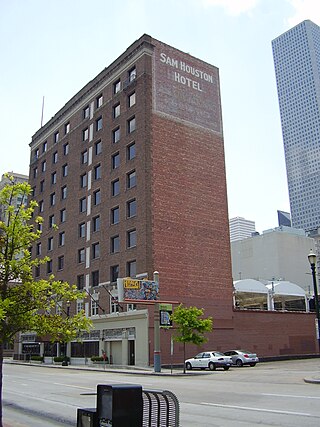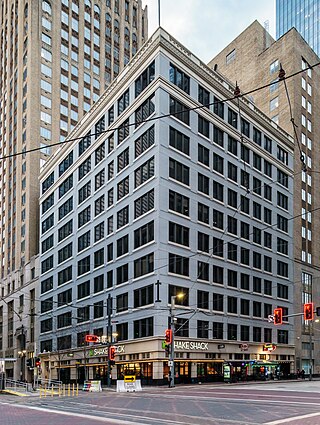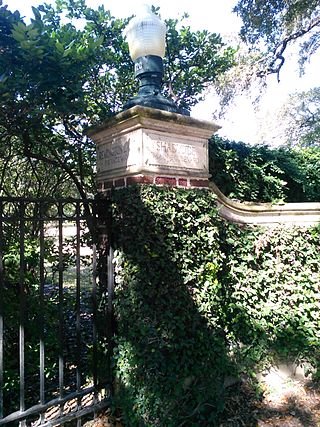
Swampscott Town Hall, previously the Elihu Thomson House, is a historic building in Swampscott, Massachusetts. The house was designed by architect James T. Kelley and built in 1889 for the noted inventor, electrical engineer, and industrialist Elihu Thomson (1853-1937). Thomson was, with Edwin J. Houston, co-founder of the Thomson-Houston Electric Company which would later merge with Thomas Edison's Edison General Electric Company to become the General Electric Company. The house was built with an observatory, which no longer exists. It has housed Swampscott town offices since 1944, when it was given to the town by Thomson's heirs. The building was declared a National Historic Landmark in 1976 for its association with Thomson.

South Main Baptist Church is a Baptist church in Houston, Texas. Located in Houston's midtown area, the church has a long history in the city. The church was named "Church of the Year" by Guideposts Magazine.

Joseph Stephen Cullinan was a U.S. oil industrialist. Although he was a native of Pennsylvania, his lifetime business endeavors would help shape the early phase of the oil industry in Texas. He founded The Texas Company, which would eventually be known as Texaco Incorporated.
Thomas Peter Lee was born on March 19, 1871, in Petroleum, West Virginia to Alexander and Martha Jane Mount Lee, Thomas Peter Lee left school at the age of sixteen and went to work in the oil fields, first in his native state and then in Ohio. In 1903 he moved to Saratoga, Texas, where he gained employment with the newly formed Texas Company, which eventually became Texaco, and when he left that organization ten years later, he had attained the rank of general superintendent of production. While there, however, he became friends with J.S. Cullinan, and the two, along with Emerson Francis Woodward, Will C. Hogg, and James L. Autry, joined in 1914 to form the Farmers Petroleum Company, of which Lee became president.

The Link–Lee House is a large historic home located in Montrose in central Houston, Harris County, in the U.S. state of Texas. It is currently serving as the executive office of the University of St. Thomas. It was added to the National Register of Historic Places listings in Harris County, Texas in 2000, and became a Recorded Texas Historic Landmark in 2001.
Wyatt Cephus Hedrick was an American architect, engineer, and developer most active in Texas and the American South. He began his career as an engineer, working in Virginia and Texas. He started his own firm in Fort Worth, and later merged with the architecture firm of Sanguinet & Staats before buying out the interests of the senior partners.

The Sam Houston Hotel is a historic hotel in Downtown Houston, Texas, United States that is listed in the National Register of Historic Places. The hotel received its listing on April 17, 2002.

Alfred Charles Finn was an American architect. He started in the profession with no formal training in 1904 as an apprentice for Sanguinet & Staats. He worked in their offices in Dallas, Fort Worth, and Houston. His credits during his tenure residential structures, but firm was a leader in steel-frame construction of skyscrapers.

The Great Jones Building is a building in Downtown Houston at the intersection of Capitol Street and Main Street.

Sanguinet & Staats was an architectural firm based in Fort Worth, Texas, with as many as five branch offices in Texas. The firm specialized in steel-frame construction and built many skyscrapers in Texas. The firm also accepted commissions for residential buildings, and designed many buildings listed on the National Register of Historic Places.

The William J. Bryce House, known as Fairview, is located on 4900 Bryce Avenue in Fort Worth, in the U.S. state of Texas.

Shadyside is a private, walled subdivision of 16 houses in Houston, Texas. In 2012 Terrence McCoy of the Houston Press said that Shadyside has a "sense of exclusivity, or as Heritage Texas Properties puts it, 'mystique,'" which caused many prominent figures from Houston to settle in Shadyside and continue doing so for a period of almost 100 years.

The JW Marriott Downtown Houston is a hotel located at 806 Main Street in Downtown Houston, which opened in 2014. It had been previously known as the Carter Building, and was the tallest building in Texas when it opened in 1910. The building was renamed Second National Bank Building in 1923.

The State National Bank Building is a high-rise office building located at 412 Main Street in downtown Houston, Texas. Designed by architect Alfred Charles Finn, the building was built in 1923 in the Spanish colonial style. It was listed on the National Register of Historic Places on August 11, 1982.

The Great Southwest Building, formerly the Petroleum Building and the Great Southwest Life Building, is a historic commercial skyscraper located at 1314 Texas Avenue in Downtown Houston, Texas, United States. Originally built in 1927 as an office space for The Texas Company, the building is now the site of the Cambria Hotel Houston Downtown Convention Center. It was listed on the National Register of Historic Places on August 8, 2019, for its historical and architectural significance.
The Baldridge House is a historic three-story mansion in Fort Worth, Texas, U.S. It was built from 1910 to 1913 for Earl Baldridge, a cattleman and rancher who later became a banker, and his wife Florence. It was designed by Sanguinet & Staats. It was purchased by Paun Peters, the president of the Western Production Company, in 2007. It was listed for sale for $8 million in 2017.
Courtlandt Place, Houston is a residential subdivision consisting of a single street, south of downtown Houston, planned in 1906. Courtlandt Place is a member of the Neartown Houston Association.
James L. Autry House may refer to:

Charles D. Hill was an American architect practicing in Dallas, Texas during the first three decades of the twentieth century.
American Republics Corporation was a Texas oil company that was founded by Joseph S. Cullinan in Houston, Texas in 1916. Joseph S. Cullinan owned Farmers Oil Company and other companies. Cullinan consolidated with twenty subsidiary companies into the American Republics Corporation. American Republics Corporation became the holding company for all the subsidiary. By 1927 American Republics Corporation owned two million acres of oil land, refineries, rail tankers and tanker ships. Cullinan resigned as president of American Republics Corporation in 1928. During the Great Depression American Republics Corporation was forced into receivership. In 1936 Cullinan returned and became president again. American Republics Corporation was active in supporting the World War II efforts with oil supply and tanker ships.














